Detrital Mica Composition Quantitatively Indicates the Sediment Provenance along the Subei Coast to the Yangtze Estuary
Abstract
:1. Introduction
2. Regional Settings and Methods
2.1. Regional Settings
- (1)
- Yangtze River (Changjiang)
- (2)
- Ancient Yellow River
- (3)
- Subei littoral plain area
- (4)
- Currents Tides and Sediment Transportation
2.2. Methods
2.2.1. Sampling
2.2.2. Mineral Separation and Identification
2.2.3. Multivariate Statistical Analysis and Calculation of Provenance Contribution
3. Results
3.1. Mica Contents in the Very Fine Sand Fraction of Yangtze Estuary Sediments
3.2. Mica Contents in the Very Fine Sand Fraction of Ancient Yellow Estuary Sediments
3.3. Mica Contents in the Very Fine Sand Fraction of Subei Littoral Plain Area Sediments
4. Discussion
4.1. Differences in Detrital Mica Contents in Sediments between the Yangtze River Estuary and Ancient Yellow River Estuary and the Causes of these Differences
4.2. Specific Diagnostic Indices to Effectively Distinguish detritus between the Yangtze River Estuary and Ancient Yellow River Estuary
4.3. Variation in the Mica-Specific Diagnostic Indices for the Very Fine Sand Fraction of Coastal Sediments in the Subei Littoral Plain Area and Provenance Significance
4.4. Quantitative Contributions of the Yangtze River and the Ancient Yellow River to Detrital Micas in the Subei Littoral Plain Area and Indicative Significance
5. Conclusions
Author Contributions
Funding
Institutional Review Board Statement
Informed Consent Statement
Data Availability Statement
Acknowledgments
Conflicts of Interest
Appendix A
References
- Wang, F.; Zhang, W.G.; Nian, X.M.; Andrew, P.R.; Zhao, X.; Shang, Y.; Ge, C.; Dong, Y. Magnetic evidence for Yellow River sediment in the late Holocene deposit of the Yangtze River Delta, China. Mar. Geol. 2020, 427, 106274. [Google Scholar] [CrossRef]
- Zhang, W.G.; Xing, Y.; Yu, L.Z.; Feng, H.; Lu, M. Distinguishing sediments from the Yangtze and Yellow Rivers, China: A mineral magnetic approach. Holocene 2008, 18, 1139–1145. [Google Scholar] [CrossRef]
- Zhang, W.G.; Ma, H.L.; Ye, L.P.; Dong, C.Y.; Yu, L.Z.; Huang, F. Magnetic and geochemical evidence of Yellow and Yangtze River influence on tidal flat deposits in northern Jiangsu Plain, China. Mar. Geol. 2012, 319–322, 47–56. [Google Scholar] [CrossRef]
- Wang, K.S.; Shi, X.F.; Jiang, X.L. Sediment provenance and province of the southern Yellow Sea: Evidence from light mineral. Chin. Sci. Bull. 2003, 48, 30–36. [Google Scholar] [CrossRef]
- Zou, L.; Dou, Y.G.; Hu, X.h.; Hu, B.Q.; Lin, X. Provenance analysis for surface sediments in different sepositional environments of the middle-south Okinawa Trough. Mar. Geol. Quat. Geol. 2021, 41, 115–124, (In Chinese with English Abstract). [Google Scholar]
- Lu, J.; Li, A.C.; Zhang, J.; Huang, P. Yangtze River-derived sediments in the southwestern South Yellow Sea: Provenance discrimination and seasonal transport mechanisms. J. Asian Earth. Sci. 2019, 176, 353–367. [Google Scholar] [CrossRef]
- Fan, D.J.; Yang, Z.S.; Mao, D.; Guo, Z.G. Clay minerals and geochemistry of the sediments from the Yangtze and Yellow rivers. Mar. Geol. Quat. Geol. 2001, 4, 7–12, (In Chinese with English Abstract). [Google Scholar]
- Yang, Z.S. Mineralogical assemblages and chemical characteristics of clays from sediments of the Huanghe, Changjiang, Zhujiang Rivers and their relationship to the climate environment in their sediment source areas. Oceanol. Limnetica Sin. 1988, 19, 336–346, (In Chinese with English Abstract). [Google Scholar]
- Zhang, Z.P.; Chu, Z.X. Modern variations in clay minerals in mud deposits of the Yellow and East China Seas and their geological significance. Holocene 2017, 28, 386–395. [Google Scholar] [CrossRef]
- He, L.B.; Liu, Q.Y. Chemical characteristics of clay minerals in the sediments from the Yellow River and the Changjiang River. Chin. Sci. Bull. 1997, 42, 488–491. [Google Scholar] [CrossRef]
- Zhao, J.S.; Zhou, J.; Chen, Q.; Zhen, K.G. Identification of Yangtze River and Yellow River Paleochannels in South Yellow Sea Shelf. Adv. Mater. Res. 2013, 664, 21–27. [Google Scholar] [CrossRef]
- Yang, Z.S.; Fan, D.J.; Guo, Z.G.; Mao, D. Distribution of the carbonate clast size and the provenance analyses of the surface sediments in the northern East China Sea. Acta Sedimentol. Sin. 2002, 20, 1–6, (In Chinese with English Abstract). [Google Scholar]
- Chen, J.; Chou, G.; Yang, J.D. Sr isotopic composition of carbonate in loess and identification of primary and secondary carbonate. Prog. Nat. Sci. 1997, 6, 731–734, (In Chinese with English Abstract). [Google Scholar]
- Liu, D.S. Loess and the Environment; Science Press: Beijing, China, 1985; pp. 1–251. (In Chinese) [Google Scholar]
- Yang, Z.S.; Wang, H.C.; Qiao, S.Q. Carbonate minerals in esturay sediments of the Changjiang and Huanghe: The content, morphology, and influential factors. Oceanol. Limnetica Sin. 2009, 40, 674–681, (In Chinese with English Abstract). [Google Scholar]
- Zhang, J.Q.; Li, C.X.; Cong, Y.Z. Hydrodynamic environment and source of the old tidal sand body in the coastal plain of the northern Jiangsu. Acta Oceanol. Sin. 1998, 20, 82–90, (In Chinese with English Abstract). [Google Scholar]
- Jin, B.F.; Wang, M.Y.; Yue, W. Comparative analysis of heavy mineral characteristics of sediments from the Huanghe River and the Changjiang River based on the multiple-window grain size strategy. Cont. Shelf Res. 2021, 216, 104326. [Google Scholar] [CrossRef]
- Wang, Z.-B.; Li, R.-H.; Yang, S.-Y.; Bai, F.-L.; Mei, X.; Zhang, J.; Lu, K. Comparison of detrital mineral compositions between stream sediments of the Yangtze River (Changjiang) and the Yellow River (Huanghe) and their provenance implication. China Geol. 2019, 2, 169–178. [Google Scholar] [CrossRef]
- An, Y.H.; Liu, J.; Zhang, J.Q.; Chen, B.; Chen, L.L.; Zhang, X.; Sheng, S. Comparative researches on the provenance indicators of Huaihe River, Yangtze River and Yellow River sediments. Quat. Sci. 2020, 3, 837–850, (In Chinese with English Abstract). [Google Scholar]
- Yang, S.Y.; Jung, H.S.; Choi, M.S.; Li, C.X. The rare Earth element compositions of the Changjiang (Yangtze) and Huanghe (Yellow) River sediments. Earth Planet. Sci. Lett. 2002, 201, 407–419. [Google Scholar] [CrossRef]
- Yang, S.Y.; Li, C.X.; Zhu, J.C.; Zhang, J.L. Provenance indicator of chemical fingerprint of magnetite in the Yangtze and Yellow river sediments. Geochimica 2000, 5, 480–484, (In Chinese with English Abstract). [Google Scholar]
- Wang, Y.H.; Shen, H.T.; Zhang, W.G. A preliminary comparison of magnetic properties of sediments from the Changjiang and the Huanghe Estuaries. Acta Sedimentol. Sin. 2004, 22, 658–663, (In Chinese with English Abstract). [Google Scholar]
- Lu, K.; Qin, Y.C.; Wang, Z.B.; Huang, L.; Li, G.X. Heavy mineral provinces of the surface sediments in central-southern East China Sea and implications for provenance. Mar. Geol. Front. 2019, 35, 20–26, (In Chinese with English Abstract). [Google Scholar]
- Sun, B.Y. Detrital mineral assemblages in the Huanghe, Changjiang and Zhujiang Delta sediments. Mar. Geol. Quat. Geol. 1990, 10, 23–34, (In Chinese with English abstract). [Google Scholar]
- Lin, X.T.; Li, W.R.; Shi, Z.B. Characteristics of mineralogy in the clastic sediments from the Yellow River provenance, China. Mar. Geol. Quat. Geol. 2003, 23, 17–21, (In Chinese with English Abstract). [Google Scholar]
- Lv, Q.R. Mineral characteristics of fine-grain sediment and its sedimentary differentiation in Changjiang estuary. Shanghai Geol. 1992, 43, 18–25, (In Chinese with English Abstract). [Google Scholar]
- Fan, S.M.; Jin, B.F.; Wang, X.; Yu, H.Y. Mica shape factor and its equivalent sedimentation in the sediment of the Yellow River Estuary. Mar. Geol. Front. 2021, 5, 31–38, (In Chinese with English Abstract). [Google Scholar]
- Doyle, L.J.; Carder, K.; Steward, R.G. The Hydraulic Equivalence of Mica. J. Sediment. Petrol. 1983, 53, 643–648. [Google Scholar]
- Sun, X.; Kuiper, K.F.; Tian, Y.; Li, C.; Gemignani, L.; Zhang, Z.; Wijbrans, J.R. Impact of hydraulic sorting and weathering on mica provenance studies: An example from the Yangtze River. Chem. Geol. 2019, 532, 119359. [Google Scholar] [CrossRef]
- Gemignani, L.; Kuiper, K.F.; Wijbrans, J.R.; Sun, X.; Santato, A. Improving the precision of single grain mica 40Ar/39Ar-dating on smaller and younger muscovite grains: Application to provenance studies. Chem. Geol. 2019, 511, 100–111. [Google Scholar] [CrossRef]
- Thierry, B.B.; Lebogang, M.; Chris, M.; Kelebogile, P.; Tebogo, K. Multistage gold mineralization events in the Archean Tati greenstone Belt, northeast Botswana: Constraints from integrative white mica Ar/Ar, garnet U-Pb and sulfides Pb/Pb geochronology. Precambrian Res. 2020, 339, 105623. [Google Scholar]
- Wang, K.S.; Shi, X.F.; Cai, S.W.; Qiao, S.Q.; Jiang, X.L. Distribution and provenance of the surface sediments of the Yellow River Mouth and Laizhou Bay deduced from heavy minerals. Mar. Geol. Quat. Geol. 2010, 30, 1–8, (In Chinese with English Abstract). [Google Scholar] [CrossRef]
- Zhang, F.Y.; Meng, Y. Heavy mineral distribution and magnetic characteristic of surface sediments in the north branch of the Changjiang River. Mar. Geol. Quat. Geol. 2011, 31, 31–41, (In Chinese with English Abstract). [Google Scholar] [CrossRef]
- Hong, Q.Y.; Shi, M.D.; Cheng, H.T. Changjiang Water Resources Commission. The History of Yangtze River; Encyclopedia of China Publishing House: Beijing, China, 2007; pp. 25–77. (In Chinese) [Google Scholar]
- Liu, J.P.; Milkman, J.D.; Gao, S.; Chen, P. Holocene development of the Yellow River’s subaqueous delta North Yellow Sea. Mar. Geol. 2004, 209, 45–67. [Google Scholar] [CrossRef]
- Xue, C.T.; Zhou, Y.Q.; Zhu, X.H. The Huanghe River course and delta from end of Late Pleistocene to the 7th century BC. Acta Sedimentol. Sin. 2004, 26, 48–61, (In Chinese with English Abstract). [Google Scholar]
- Ren, M.E. China’s Three Deltas; Higher Education Press: Beijing, China, 1994; pp. 56–73. (In Chinese) [Google Scholar]
- Dai, Y.S. Basic characteristics of geological structure in the Yellow River Basin. Yellow River 1984, 3, 20–26, (In Chinese with English Abstract). [Google Scholar]
- Ren, M.; Shi, Y. Sediment discharge of the Yellow River (China) and its effect on the sedimentation of the Bohai and the Yellow Sea. Cont. Shelf Res. 1986, 6, 785–810. [Google Scholar] [CrossRef]
- Wang, Y.; Zhang, Z.K.; Zhu, D.K.; Yang, J.H.; Mao, L.J.; Li, S.H. River-sea interaction and the north Jiangsu plain formation. Quat. Sci. 2006, 26, 301–320, (In Chinese with English Abstract). [Google Scholar]
- Zhao, Q.J. Influence of river on development of Jiangsu coast. Mar. Sci. 1992, 3, 53–55, (In Chinese with English Abstract). [Google Scholar]
- Zhang, Y. A study of characteristics and sources of clay minerals of sediments in coastal areas of Jiangsu province. Mar. Sci. 1990, 4, 34–42, (In Chinese with English Abstract). [Google Scholar]
- Yang, S.Y.; Li, C.X.; Zhang, J.Q. Palaeogeographic evolution of coastal plain and provenance study of postglacial sediments in north Jiangsu province. J. Palaeogeogr. 2000, 2, 68–75, (In Chinese with English Abstract). [Google Scholar]
- Li, C.X.; Zhang, J.Q.; Fan, D.D.; Deng, B. Holocene regression and the tidal radial sand ridge system formation in the Jiangsu coastal zone, east China. Mar. Geol. 2001, 1731, 97–120, (In Chinese with English Abstract). [Google Scholar] [CrossRef]
- Yi, S.Q.; Chen, B.B.; Wang, S.H. Numerical classification of clay minerals in beach soil of Jiangsu. Acta Sedimentol. Sin. 1998, 25, 349–355, (In Chinese with English Abstract). [Google Scholar]
- Guo, Z.G.; Yang, Z.S.; Zhang, D.Q. Seasonal distribution of suspended matter in the northern East China Sea and barrier effect of current circulation on its transport. Acta Oceanol Sin. 2002, 5, 71–80, (In Chinese with English Abstract). [Google Scholar]
- Liu, Z.L.; Hu, D.X.; Tang, X.H. Tidal current observation in the southern Yellow Sea in the summers of 2001 and 2003. Chin. J. Oceanol. Limnol. 2008, 26, 121–129. [Google Scholar] [CrossRef]
- Chen, B.; Zhou, L.Y.; Liu, J.; Wang, K. The relationship between the suspended sediment movement and tidal current dynamic characteristic in Old Yellow Delta. Mar. Sci. 2011, 5, 73–81, (In Chinese with English Abstract). [Google Scholar]
- Zhao, B.R.; Fang, G.H.; Cao, D.M. Characteristics of tidal residual currents and their relations with coastal current transports in the Bohai Sea, Yellow Sea and East China Sea. Stud. Mar. Sin. 1995, 36, 5–10. [Google Scholar]
- Xia, C.S.; Qiao, F.L.; Yang, Y.Z.; Yuan, Y.L. Simulation of double cold cores of the 35° N section in the Yellow Sea with a wave-tide-circulation coupled model. Chin. J. Oceanol. Limnol. 2004, 22, 292–298. [Google Scholar]
- Wu, H.; Gu, J.H.; Zhu, P. Winter Counter-Wind Transport in the Inner Southwestern Yellow Sea. J. Geophys. Res. Ocean. 2018, 123, 411–436. [Google Scholar] [CrossRef]
- Ingersoll, R.V.; Bullard, T.F.; Ford, R.L.; Grimm, J.P.; Pickle, J.D.; Sares, S.W. The effect of grain size on detrital modes: A test of the Gazzi–Dickinson pointcounting method. J. Sediment. Petrol. 1984, 54, 103–116. [Google Scholar]
- Fan, D.; Sun, X.; Yang, Z.; Guo, Z. A mathematical model on the quantitative provenance identification: Take the identification of the surface sediment sources from ECS as example. Acta Sedimentol. Sin. 2002, 20, 30–33, (In Chinese with English Abstract). [Google Scholar]
- Wang, K.S.; Wang, G.Q.; Cai, S.W.; Dou, Y.G.; Shi, X.F.; Cheng, Z.B.; Jiang, X.L. Heavy mineral characteristics of surface sediments in the subaqueous Yangtze River Delta. Mar. Geol. Quat. Geol. 2007, 1, 7–12, (In Chinese with English Abstract). [Google Scholar]
- Wang, L.C.; Chen, X.L.; Chu, T.Q. A contrast analysis on the loads character of the Changjiang River and the Yellow River. Geogr. Res. 1997, 16, 71–79, (In Chinese with English Abstract). [Google Scholar]
- Weltje, G.J.; von Eynatten, H. Quantitative provenance analysis of sediments: Review and outlook. Sediment. Geol. 2004, 171, 1–11. [Google Scholar] [CrossRef]
- Zheng, H.H.; Theng, B.K.G.; Whitton, J.S. Mineral composition of loess-paleosol in the Loess Plateau of China and its environment implication. Geochimica 1994, 23, 113–123, (In Chinese with English Abstract). [Google Scholar]
- Li, J.Y.; Zhang, J. Chemical weathering processes and atmospheric CO2 consumption of Huanghe River and ChangJiang River basins. Sci. Geogr. Sin. 2005, 15, 16–21. [Google Scholar] [CrossRef]
- Chen, J.Y.; Yun, C.X.; Hu, H.G. The model of development of the Changjiang Estuary during the last 2000 years. In Estuarine Comparisons; Kennedy, V.S., Ed.; Academic Press: New York, NY, USA, 1982; pp. 655–666. [Google Scholar]
- Hongfei, Z.; Yunhong, L.; Claudio, O.D.; Yue, M.; Jie, Z.; Hongming, H. Contribution of soil erosion to the evolution of the plateau-plain-delta system in the Yellow River basin over the past 10,000 years. Palaeogeogr. Palaeoclimatol. Palaeoecol. 2022, 601, 111133. [Google Scholar]
- Pal, D.K.; Srivastava, P.; Durge, S.L.; Bhattacharyya, T. Role of weathering of fine-grained micas in potassium management of Indian soils. Appl. Clay Sci. 2001, 20, 39–52. [Google Scholar] [CrossRef]

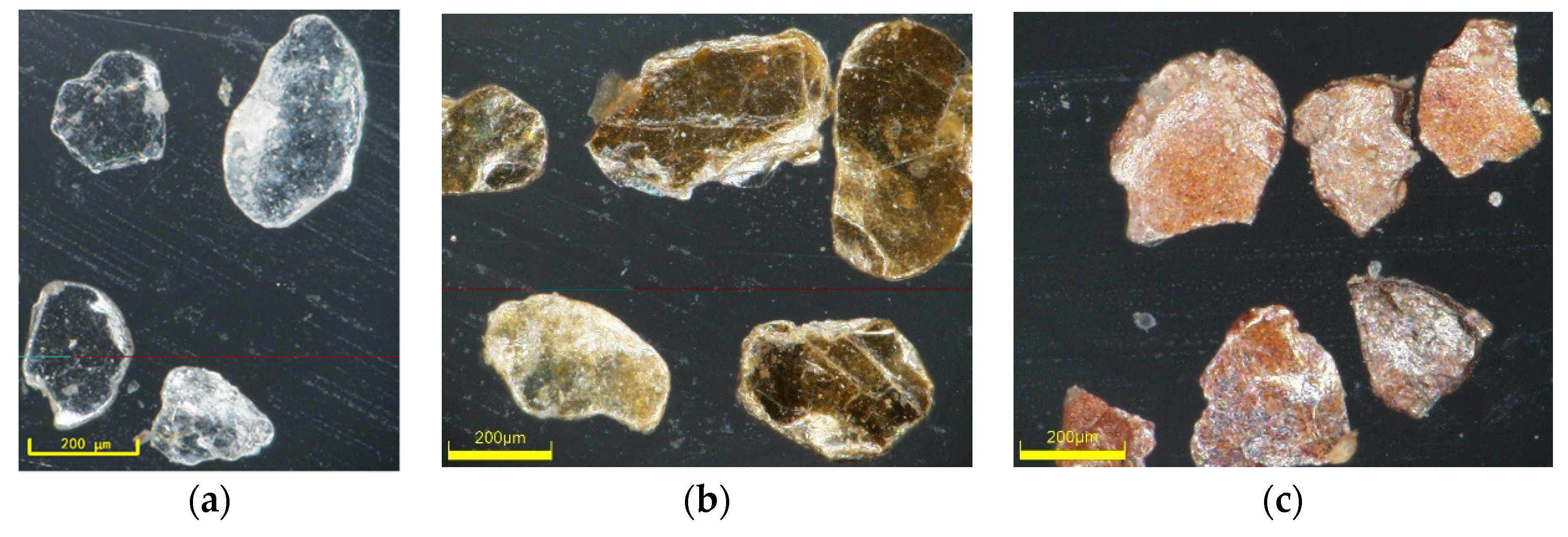
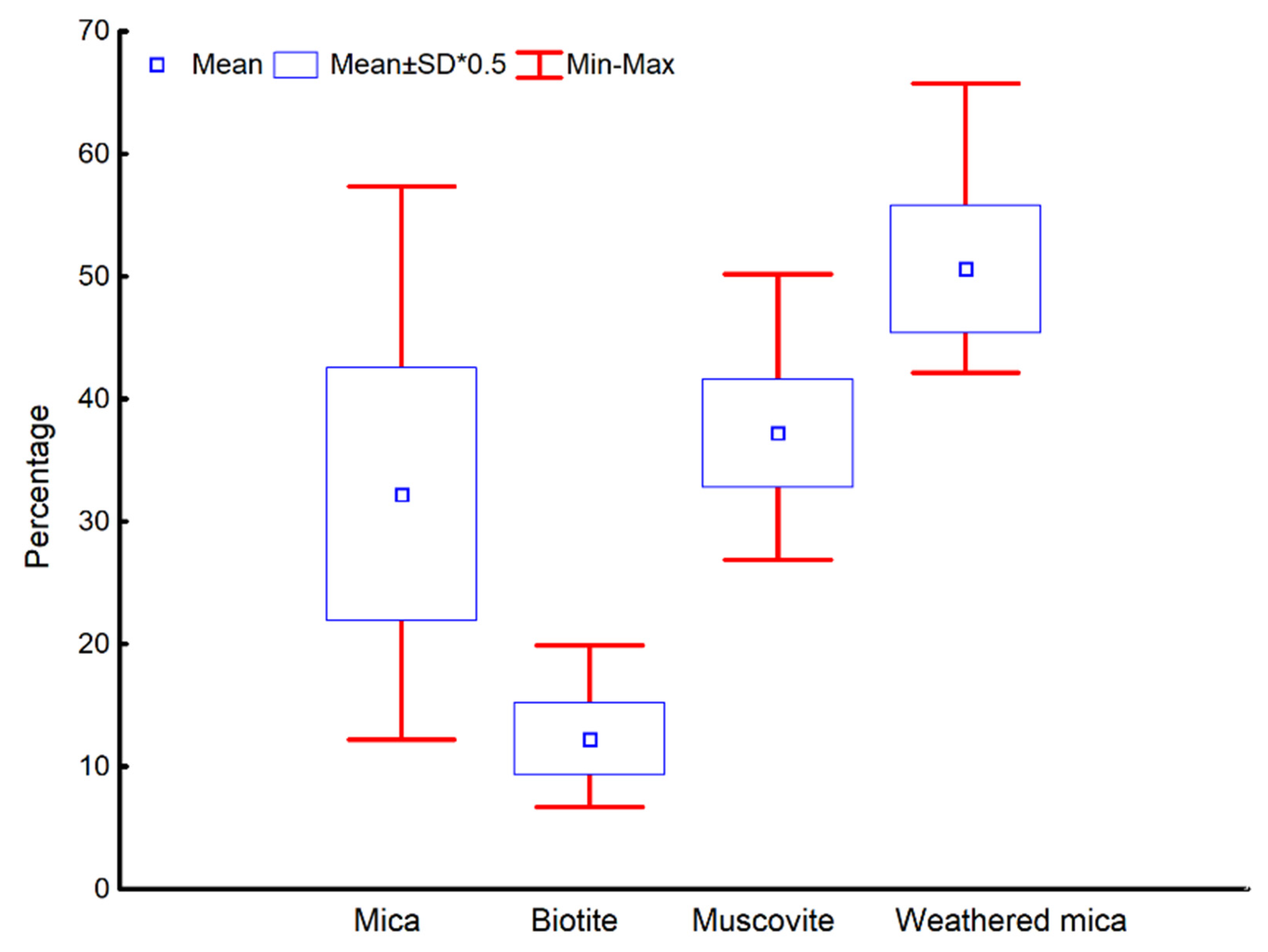


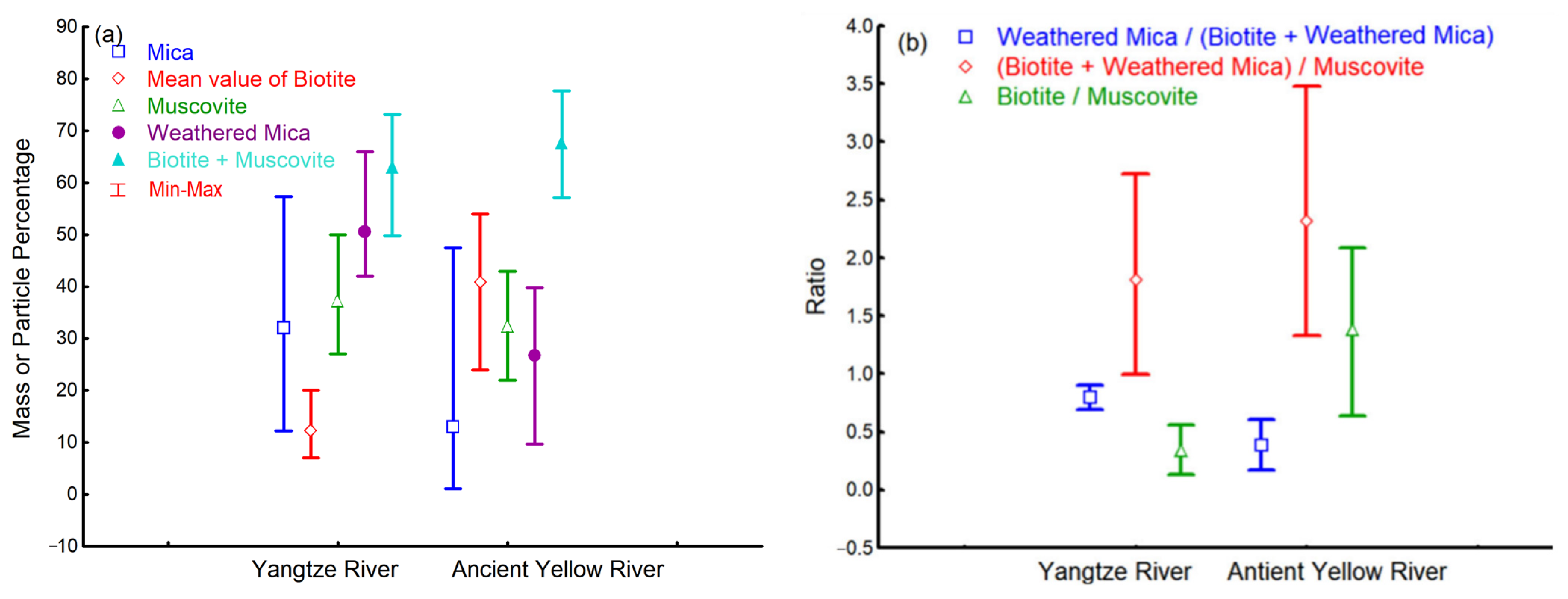


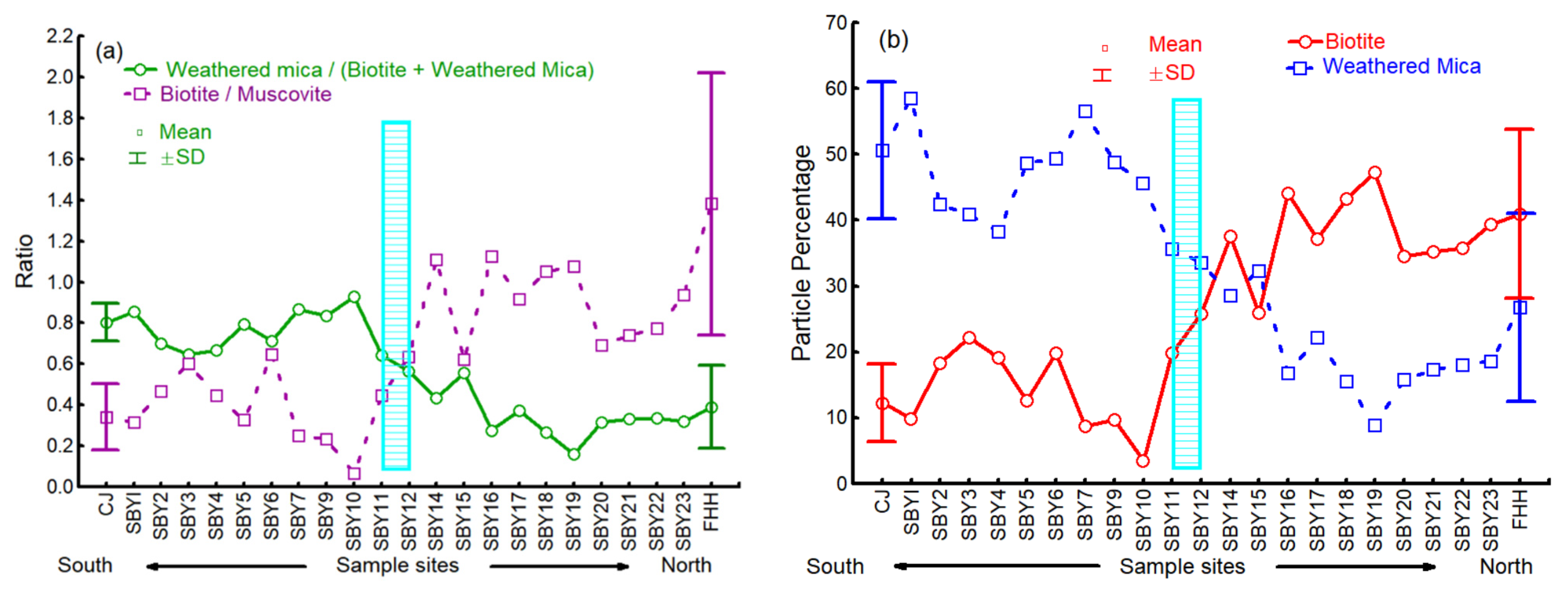
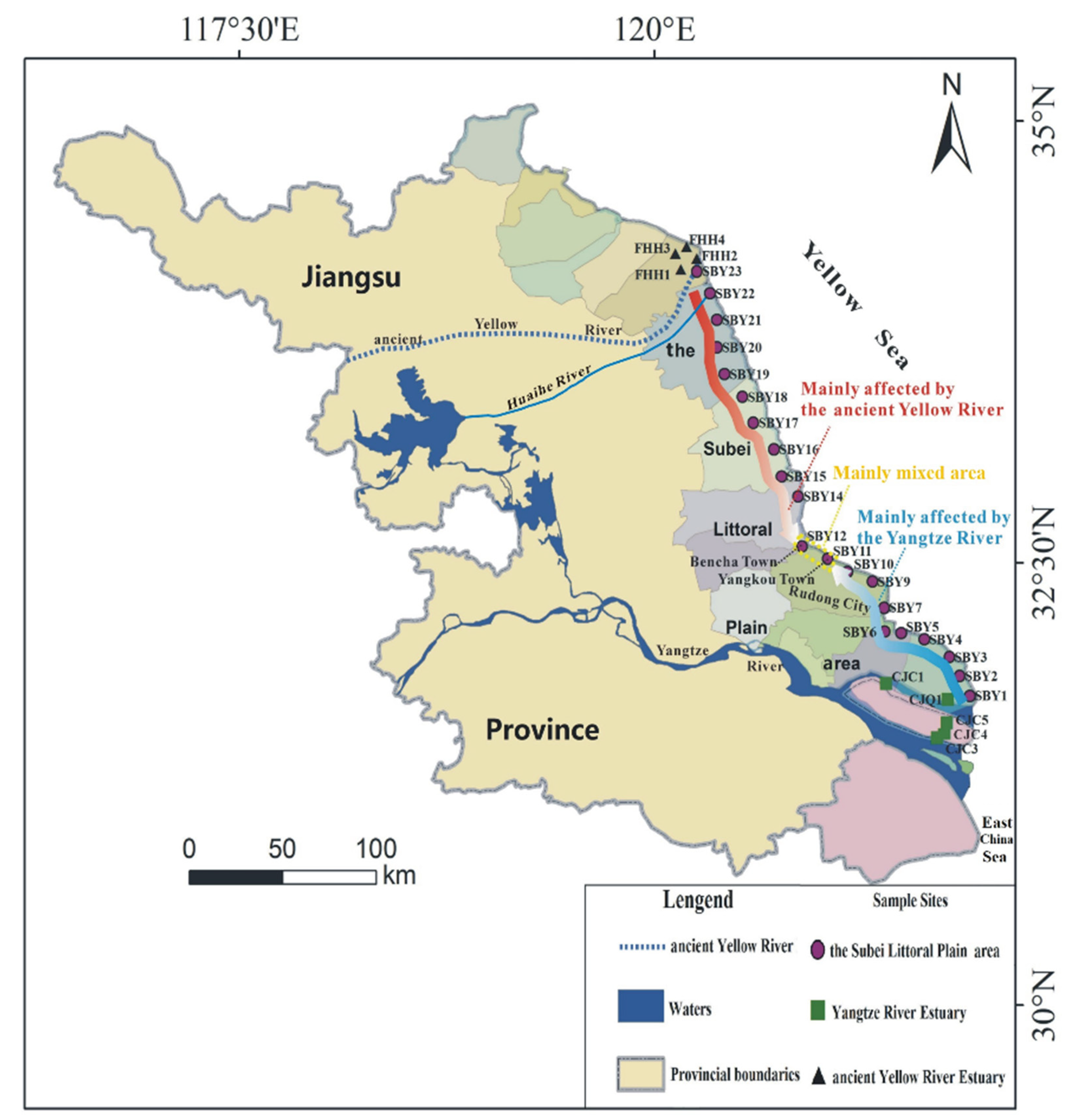

| Samples | Regression Coefficient | Test Indices of the Regression Model | |||||
|---|---|---|---|---|---|---|---|
| a1 | a2 | ε | Final Loss | R | R2 | Variance Explained | |
| SBY1 | 1.00 | 0.00 | 1.39 | 61.6 | 0.987 | 0.973 | 97.3 |
| SBY2 | 0.72 | 0.23 | −0.03 | 0.01 | 1.00 | 1.00 | 100 |
| SBY3 | 0.62 | 0.36 | −0.05 | 0.01 | 1.00 | 1.00 | 100 |
| SBY4 | 0.60 | 0.29 | −0.04 | 0.03 | 1.00 | 1.00 | 100 |
| SBY5 | 0.95 | 0.02 | 0.00 | 0.00 | 1.00 | 1.00 | 100 |
| SBY6 | 0.90 | 0.10 | 1.53 | 14.7 | 0.995 | 0.991 | 99.1 |
| SBY7 | 1.00 | 0.00 | 0.59 | 47.0 | 0.989 | 0.978 | 97.8 |
| SBY9 | 0.97 | 0.00 | −0.62 | 3.30 | 0.999 | 0.998 | 99.8 |
| SBY10 | 0.92 | 0.00 | −2.20 | 43.4 | 0.985 | 0.970 | 97.0 |
| SBY11 | 0.53 | 0.33 | −0.05 | 0.04 | 1.00 | 1.00 | 100 |
| SBY12 | 0.39 | 0.51 | −0.08 | 0.03 | 1.00 | 1.00 | 100 |
| SBY14 | 0.10 | 0.89 | −0.07 | 0.01 | 1.00 | 1.00 | 100 |
| SBY15 | 0.36 | 0.53 | −0.08 | 0.04 | 1.00 | 1.00 | 100 |
| SBY16 | 0.00 | 0.99 | −1.59 | 95.6 | 0.961 | 0.924 | 92.4 |
| SBY17 | 0.00 | 0.90 | −0.40 | 3.20 | 0.998 | 0.997 | 99.7 |
| SBY18 | 0.00 | 0.96 | −1.70 | 107.4 | 0.955 | 0.911 | 91.1 |
| SBY19 | 0.00 | 0.99 | −2.87 | 324.0 | 0.885 | 0.783 | 78.3 |
| SBY20 | 0.00 | 0.80 | −1.00 | 30.5 | 0.980 | 0.961 | 96.1 |
| SBY21 | 0.00 | 0.82 | −0.86 | 21.3 | 0.987 | 0.974 | 97.4 |
| SBY22 | 0.00 | 0.84 | −0.82 | 19.3 | 0.989 | 0.977 | 97.7 |
| SBY23 | 0.00 | 0.91 | −1.03 | 34.9 | 0.983 | 0.966 | 96.6 |
Publisher’s Note: MDPI stays neutral with regard to jurisdictional claims in published maps and institutional affiliations. |
© 2022 by the authors. Licensee MDPI, Basel, Switzerland. This article is an open access article distributed under the terms and conditions of the Creative Commons Attribution (CC BY) license (https://creativecommons.org/licenses/by/4.0/).
Share and Cite
Dong, Z.; Zhang, L.; Jin, B. Detrital Mica Composition Quantitatively Indicates the Sediment Provenance along the Subei Coast to the Yangtze Estuary. Appl. Sci. 2022, 12, 12653. https://doi.org/10.3390/app122412653
Dong Z, Zhang L, Jin B. Detrital Mica Composition Quantitatively Indicates the Sediment Provenance along the Subei Coast to the Yangtze Estuary. Applied Sciences. 2022; 12(24):12653. https://doi.org/10.3390/app122412653
Chicago/Turabian StyleDong, Zhicheng, Lina Zhang, and Bingfu Jin. 2022. "Detrital Mica Composition Quantitatively Indicates the Sediment Provenance along the Subei Coast to the Yangtze Estuary" Applied Sciences 12, no. 24: 12653. https://doi.org/10.3390/app122412653




